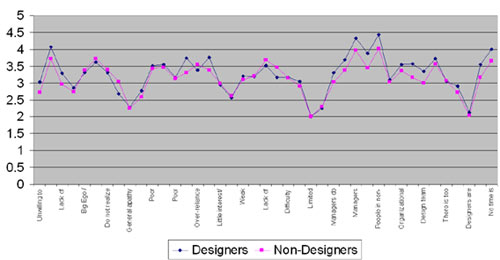Why Designers Fail: The Report
Why designers succeed and fail in organizations is mostly a matter of opinion as there’s little data to support theories or make claims. To help ground discussions on this subject I ran a research study on why designers fail – exploring the psychological, skill and organizational reasons why designers, and people who work with designers, believe designers don’t achieve the results they desire (PDF of survey questions here).
Update: this research was originally presented at UIE 13, and also at MX ’08, An Event Apart Seattle ’08 and ’11. The latest version of the slides can be downloaded here, and this is the written sumation.
Top line summary
The survey consisted of 41 issues, divided into three categories: Psychological, Skill and Organization. Each participant ranked each issue on a scale from 1 to 5, with 5 meaning the issue was highly significant in explaining why designers fail, and 1 meaning least significant (3 was identified as a neutral value).
The 389 survey respondents self identified as (rounded up #s):
| Designer | 34% | |
| Project manager | 17% | |
| Programmer / Tester | 12% | |
| Usability engineer | 10% | |
| Group manager | 7% | |
| Business / Marketing | 4% | |
| Documentation | 1% | |
| Other | 17% |
The top 16 issues, ranked by average scores were:
| People in non-design roles making design decisions | 4.18 |
| Managers making design decisions w/o design training | 4.14 |
| Designers don’t seek enough data before designing | 3.92 |
| No time is provided for long term thinking | 3.81 |
| Not receptive to critical feedback | 3.69 |
| Lack of awareness of the business fundamentals | 3.66 |
| Only lip-service is paid to “User centered design” | 3.64 |
| It’s never made safe to fail or experiment | 3.62 |
| Designer’s power diluted by too many cooks | 3.60 |
| Over-reliance on one kind of design style | 3.54 |
| Poor collaboration skills | 3.51 |
| Poor persuasion / idea pitching skills | 3.49 |
| Poor communication skills | 3.49 |
| Poor understanding of domain | 3.48 |
| Pressure to use first solution, not a good solution | 3.45 |
| Big Ego / Expects others to cater to their whims | 3.41 |
Average scores per grouping
The average scores for groupings showed little different in weightings: there was no single grouping of issues that proved to be significantly more important in explaining why designers fail.
| Organizational issues: | 3.37 | |
| Skill issues: | 3.15 | |
| Psychological issues: | 3.11 |
Managers vs. Individual contributors
(Note: these charts are quick and dirty. If you’d like the raw data to generate better ones, just ask).
One research question of the study was to see how individual contributors and managers varied in their thinking on failure. 49% of those surveyed identified as playing a lead or management role.
The results showed extremely high correlation between the opinion of individuals and managers.
Designers vs. non-designers
Another research question was how designers and non-designers results would compare. The results showed only minor variance in how designers and non-designers view causes of failure.
The results showed extremely high correlation between the opinion of designers and non-designers on why designers fail.
Conclusions
- Many top reasons for failure are not typically considered design issues, such as collaboration skills, persuasion skills, and receiving critical feedback.
- General consensus on top issues: managers, non-managers, designers and non-designers all had highly similar scores.
- Nearly half of all respondents took time to write in additional issues and thoughts. There was a great deal of interest in discussing this topic further.
Background and Disclosures
- This survey was designed primarily for qualitative use and as a basis for further discussion and research. I’m sure there are flaws and bias in the study design but I believe this study is valuable anyway.
- The issue list was based on 3 things: my own experiences managing UX design training for Microsoft from 1999-2002, many years of debating this question at drunken design conference receptions, and this discussion on a previous blog post.
- The issue descriptions listed above were modified to fit in the post – see the actual survey if you’re suspicious of leading questions or other survey bias issues.
- The survey was distributed via this blog, the iXda mailing list and the pmclinic list.
- A PDF version (95k) of the actual survey can be downloaded.
You can download the slides from from my talks on this at UI13 and an An Event Apart Seattle.
I’m looking for folks to help continue this research. If you’re interested leave a comment.


